· Pledged to achieve net-zero operational greenhouse gas emissions (Scope 1 and 2) and to use clean, renewable energy at the Kamoa-Kakula Copper Mine, putting the mine firmly on track to be among the world’s lowest greenhouse gas emitters per unit of metal produced
· Implemented a Biodiversity Management Plan to protect biodiversity in the mine’s footprint
· Put employees’ safety and health first and strive to create an injury-free work environment for all employees and contractors
· Had 10,800 employees by the end of 2021, 97% of which were locals
· Founded a Sustainable Livelihoods Program. Total social development contribution was USD 1.01 billion in 2021, an increase of 42.8% from 2020
Zijin News - On June 6, 2022, the Kamoa-Kakula Mining Complex, a joint venture between Zijin Mining, Ivanhoe Mines, Crystal River Global Limited, and the DRC Government reported that Kamoa Copper has achieved approximately 112,570 tonnes of copper in concentrate produced from January 2022 to May 2022, with a monthly copper production record of 29,800 tonnes in May 2022. Inga II hydroelectric refurbishment project is progressing quickly, with main construction works scheduled to begin in July. Kamoa Copper’s greenhouse gas (GHG) emission intensity in 2021 was 0.16 tCO2e per tonne of copper produced, which is lower than the average of 0.19-2.8 tCO2e per tonne of copper produced in equivalent-scale copper mines.
Kamoa-Kakula is the world’s highest-grade copper mine. Kamoa Copper has been independently ranked as the world’s fourth-largest copper deposit by the international mining consultant Wood Mackenzie.
Kamoa-Kakula is the world’s fastest growing major copper mine. With the commencement of production in May 2021, Kamoa’s mined copper production from the first two phases has currently reached 400,000 tpa and is projected to exceed 450,000 tpa by Q2 2023. Construction works of Phase 3 expansion, including a 5-million tpa processing plant and a 500 ktpa smelting plant, are progressing as planned. The processing plant is set to commence production by Q4 2024. By then, Kamoa’s production capacity of mined copper will reach 600 ktpa. The project’s phased expansion would position Kamoa-Kakula as the world’s second-largest copper mining complex, with peak annual copper production of more than 800,000 tonnes.
Kamoa Copper strives to produce the world’s “greenest copper”. Following “carbon peak and carbon neutrality” initiatives, Kamoa Copper has implemented the Sustainable Livelihoods Program and set a net-zero GHG emission target for operation. Kamoa Copper is powered by clean and renewable energy with its main power source coming from the Mwadingusha hydropower plant and the Inga II hydropower facility. The project’s GHG emission per tonne of copper produced will continue to drop when Inga II hydroelectric refurbishment is accomplished. A 2020 independent audit of Kamoa-Kakula's GHG intensity metrics performed by Hatch Ltd. of Mississauga, Canada, confirmed that the project will be foremost among the world's lowest GHG emitters per unit of copper produced.
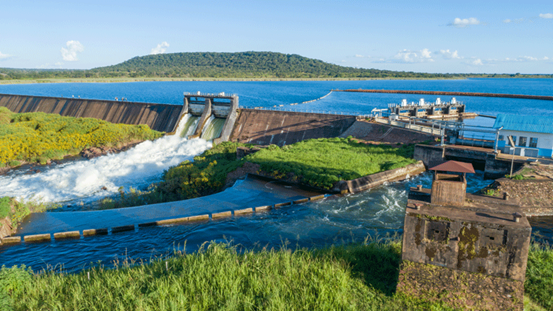
Mwadingusha hydropower plant
Climate change
Led by Zijin’s pursuit of “green development”, Kamoa Copper has built a vast area of nursery garden around the project site, which is dhome to thousands of saplings of various native tree species from the Mlombo woodlands for reforestation, seeking to build climate resilience for local communities. Kamoa Copper celebrated the 2021 Arbor Day by sourcing and planting 3,600 orange and mandarin saplings as well as 200 grafted avocado trees in the backyards of homes of project-affected communities. The aforementioned trees have numerous benefits to the community and also contribute to the larger battle against global warming. Not only do they provide shade and nutrition-rich fruit, but they also alleviate the impact of climate change by storing carbon dioxide. Their roots absorb water run-off which helps to mitigate the risk of flooding. Air quality is improved and the ecosystem balance is restored.
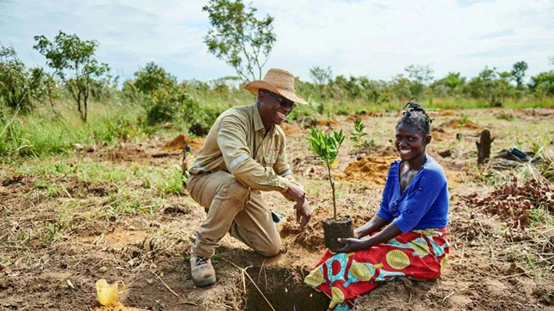
A Kamoa Copper employee plants orange and mandarin saplings with a local woman.
The Kamoa-Kakula project actively promotes the application of clean energy and the electrification to the project’s mining fleet. All six new turbines at the Mwadingusha hydropower plant were synchronized to the national electrical grid in August 2021, with each generating unit producing approximately 13 megawatts (MW) of power, for a combined output of approximately 78 MW. Meanwhile, the project fully promotes the electrification of its mining fleet by introducing new, state-of-the-art equipment powered by electric batteries or hydrogen fuel cells. Kamoa-Kakula is working closely with its mining equipment suppliers to decrease the use of fossil fuels in its mining fleet. Evaluations of the viability, safety and performance of new electric, hydrogen and hybrid technologies are being carried out for timely introduction when they become commercially available.
Biodiversity
As part of Kamoa-Kakula’s Biodiversity Management Plan (BMP), key actions are stipulated to either conserve or enhance biodiversity in all directly and indirectly affected areas.
Apiculture is practiced in most African countries, including the DRC, where there is a long history in traditional beekeeping. In traditional beekeeping practices, also known as “honey hunting,” destruction of natural forests was found in some cases. At Kamoa, however, more sustainable beekeeping practices have been put in place. In 2021, Kamoa launched phase 1 of its beekeeping initiative which provided a start-up advance of $5000 to 20 participants. This initiative enabled the beekeepers to make an income from the honey they farm and sell. Phase 1 witnessed a collection of 3,838 kg of honey and an income of $23,556 for 45 beekeepers.
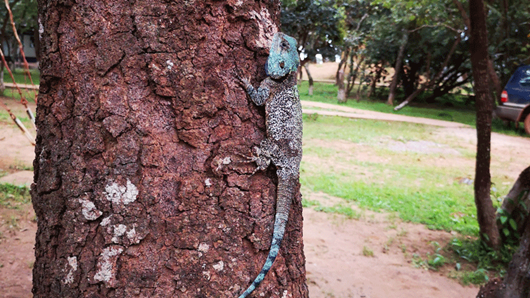
Animals in the mining area
Occupational health and safety
Our employees’ safety and health are of the utmost importance to us. Kamoa Copper strives to create an injury-free work environment for all employees and contractors. By the end of December 2021, the project accumulated 2,696,794 work hours free of any lost-time injury.
The project provides reliable laboratory-diagnostic services to employees to ensure early reponses and proper treatment response. Highly specialized laboratory equipment at the Kamoa hospital provides accurate malaria and typhoid fever diagnostics for patients.
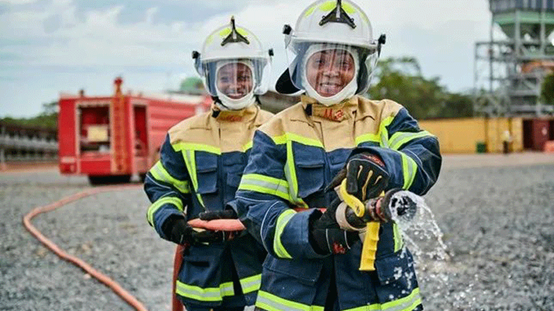
Kamoa Copper’s emergency response team
Since the breakout of the COVID-19, the Kamoa-Kakula project has been focusing on protection, prevention, and mitigation of risks. Regular testing, sanitization, screening and mask requirement are put in place to ensure that positive cases are quickly identified, isolated, and treated for minimum cross contamination. The Kamoa hospital has a Covid-19 isolation ward equipped with negative pressure technologies for better control of infectious diseases. Meanwhile, the project has taken preventative measures, such as providing vaccinations to local communities and employees. Moving forward, the project will continue to remain vigilant and maintain a high standard of risk management.
Labour management
The Kamoa-Kakula project strives to build a close relationship with the workforce and associated trade unions to ensure fair and transparent management of working conditions. By the end of 2021, the project had 10,800 employees with a 97% local employment rate.
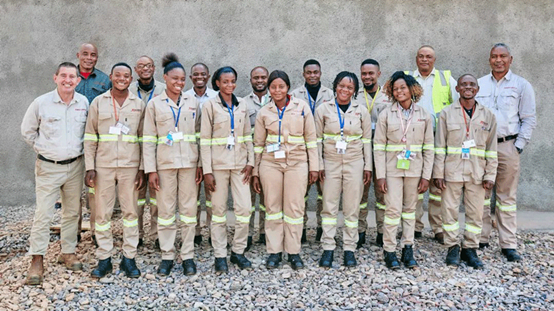
New recruits complete basic operation skill training.
With respect of gender equality, the project initiated a Women in Mining (WiM) program, seeking to improve occupational skills of female employees in technical positions. The WiM team hosted an event in 2021 to mark International Women’s Day where female attendees gathered together to share the rights and achievements they’ve gained as well as what still lies ahead to be achieved.
The Kamoa-Kakula project implements active management programs for employees’ development, and seeks to achieve a reasonable proportion of local and global employees in management positions through various measures. All-around performance management is adopted to assess employees’ strengths to unlock their full potential for occupational growth. In 2021, 312 performance reviews were conducted and 174 employees were promoted.
Community relations and development
The Kamoa-Kakula project values common development with local communities and founded a series of programs to promote community development, such as the Sustainable Livelihoods Program. In 2021, the Kamoa-Kakula project created, distributed and provided a total value of $ 1.01 billion, presenting an increase of 42.8% from 2020.
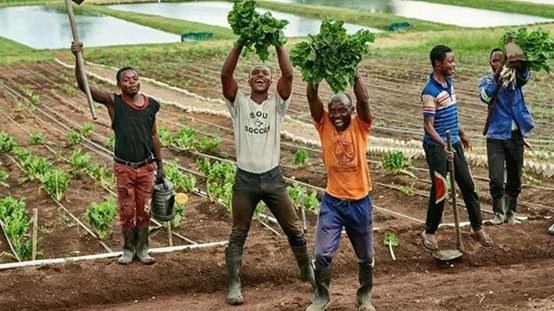
A farm near Kamoa Copper
The Kamoa-Kakula project is located in a rural area, which is home to approximately 20,000 people in 41 villages. In 2021, the project held 479 stakeholder engagement meetings with 7500 participants in total. Through transparent and ongoing dialogues, the project listened to stakeholders’ voices on key engagement themes including local employment and procurement opportunities, resettlement, livelihood restoration, queries regarding environmental impacts, social development initiatives etc. In 2021, 129 homes were relocated, with five households awaiting for new houses to be completed.
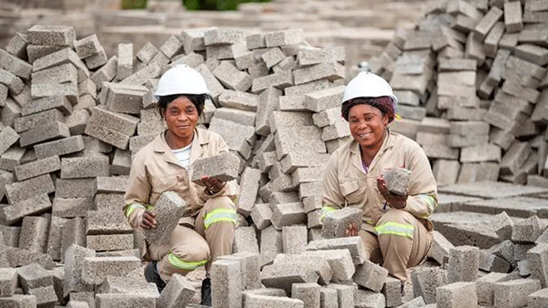
A community brick plant
The Sustainable Livelihoods Program, which started with maize and vegetable production, now includes fruit, aquaculture, poultry and honey. Today, approximately 900 community farmers are benefiting from the Sustainable Livelihoods Program, producing high-quality food for their families and selling the surplus for additional income.
The Sustainable Livelihoods Program was found in 2010 by Ivanhoe Mines, our joint venture partner, to strengthen food security and farming capacity in the host communities near Kamoa-Kakula by establishing an agricultural demonstration garden to support farmers at community level.
The construction of 100 new fishponds was completed in 2021, bringing the total number of active fishponds to 138. In 2021, 28 solar-powered water wells were installed, providing approximately 12,000 community members with easy access to clean water.
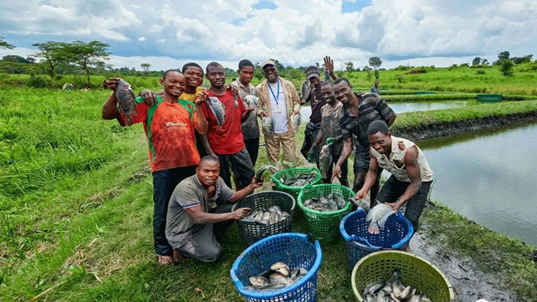
Community residents reap tilapia.
Construction of communal infrastructures in Kaponda Village, one of the project-affected communities, also progressed throughout the year, exemplified by the construction, landscaping and equipping of the Kaponda Primary School. The community church at Kaponda Village was also completed and the keys have been officially handed over to the community. The success of these initiatives marked another milestone in the ambition to advance the objectives set out in the United Nations Sustainable Development Goals. In the future, the Kamoa-Kakula Sustainable Livelihoods Program will continue to provide a series of training programs to communities, such as sewing, brickmaking, landscaping, and gardening.
The Kamoa-Kakula Mining Complex is a joint venture between Zijin Mining (39.6%), Ivanhoe (39.6%), Crystal River (0.8%), and the DRC Government (20%). Zijin Mining also holds 13.67% of interest in Ivanhoe.
Translator: Chen Peng Editor: Huang Xu Reviser: Li Yuanxing Editor-in-Chief: Wang Jie

